
The List of Lockheed F-104 Starfighter operators lists the countries and their air force units that operated the Lockheed F-104 Starfighter.

The List of Lockheed F-104 Starfighter operators lists the countries and their air force units that operated the Lockheed F-104 Starfighter.

Belgium operated F-104G and TF-104Gs. They served with four squadrons: 23 and 31 (fighter-bombers), 349 and 350 (interceptors), and finally an OCU unit. In total 101 SABCA-built F-104Gs and 12 TF-104G built by Lockheed were purchased (one F-104G crashed before delivery). The Belgian Air Force operated the type from 14 February 1963 to 19 September 1983; some survivors were sent to Taiwan (23 aircraft) and Turkey (18 aircraft). Thirty-eight F-104G and three TF-104Gs were lost in accidents.

The RCAF, and later the unified Canadian Forces, operated 200 Canadian-built CF-104s and 38 dual-control trainer CF-104Ds (built by Lockheed) between 1962 and 1986. CF-104s were equipped with additional electronic equipment, with a Radar warning receiver function, in the tail and under the nose. Losses were high, with around 110 crashes in Europe. Its heavy usage, mainly at low-level for bombing and reconnaissance missions was a major factor, while bad weather conditions contributed to almost 50% of the accidental losses. The airframes had an average of 6,000 flying hours when phased-out; triple that of Germany's F-104s. Surplus CF-104s and CF-104Ds were later transferred to Denmark, Norway, and Turkey. [1]

Denmark initially received 25 F-104G and four TF-104Gs under the Mutual Defense Assistance Act during 1964–65. Surplus Canadian license-built aircraft were transferred between 1971–73 (15 CF-104 and 7 CF-104D). A total of 51 Starfighters were operated by Denmark before their retirement in 1986. Fifteen surplus F-104Gs and three TF-104Gs were transferred to Taiwan in 1987. [2]

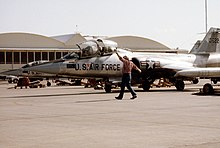

West Germany received 916 F-104s, comprising 749 F/RF-104Gs, 137 TF-104Gs and 30 F-104Fs, [4] forming the major combat equipment of both the German Air Force and Marineflieger . At its peak in the mid-1970s, the Luftwaffe operated five F-104 -equipped fighter bomber wings, two interceptor wings and two tactical reconnaissance wings. The Marineflieger operated a further two wings of F-104s in the maritime strike and reconnaissance roles. [5]
The Starfighter entered service with the Luftwaffe in July 1960, [6] with deliveries continuing until March 1973, [7] remaining in operational service until 16 October 1987, [8] and continuing in use for test purposes until 22 May 1991.
The two squadrons operating the RF-104G were re-equipped with RF-4E Phantoms in the early 1970s.
The Marineflieger initially used AS.30 command guidance missiles as anti-ship weapons, but these were replaced with the more sophisticated and longer-ranged radar-guided AS.34 Kormoran missile, allowing stand-off attacks to be carried out against enemy ships. [9] West German Starfighters proved to have an alarming accident rate, 292 of 916 Starfighters crashed, claiming the lives of 115 pilots.

Greece received 45 new-built F-104G and six TF-104s under the Military Assistance Program. These were supplemented by second-hand Starfighters passed on from other NATO air forces, including 79 from Germany, seven from the Netherlands and nine from Spain. The Starfighter entered Greek service in April 1964, equipping two wings, leaving service in March 1993. [10]


In the Italian Air Force, the F-104 was a mainstay from the early 1960s until the end of the 20th century. The first flight for an Italian F-104G was a Lockheed-built aircraft, MM6501, on 9 June 1962; however, the first Fiat/Aeritalia-built example flew two years later on 5 October 1962. Italy initially received a total of 105 F-104G, 24 TF-104G and 20 RF-104Gs, becoming operational in March 1963. This fleet was later increased by the addition of 205 built under license by Aeritalia F-104S aircraft and six ex-Luftwaffe TF-104Gs bringing the total number of aircraft operated to 360. In 1986 the AMI was the largest operator with eleven units flying the Starfighter operationally. Up to 1997, Italy lost 137 (38%) of its F-104s in 928,000 flying hours (14.7 aircraft every 100,000 hrs). The F-104 was officially retired from AMI service during a large ceremony at Pratica di Mare in 2004.
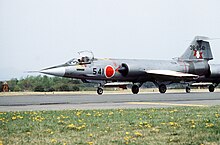

The JASDF operated 210 F-104J air-superiority fighters and 20 dual-control trainer F-104DJs. Called Eiko ("Glory"), they served from October 1962 to 1986, losing only 3 airplanes in this time including a mid-air collision accident. Seven air-superiority squadrons used them: 201, 202, 203, 204, 205, 206, 207. Japanese F-104s faced intrusive Soviet airplanes during this long service. Twenty two [11] of the Japanese F-104s were eventually converted to drones for aerial target practice. 31 F-104J and five F-104DJ [11] aircraft were sold to Taiwan. [12] [13] [14] [15]
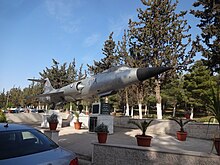
Jordan received 29 F-104A and four F-104B aircraft delivered under the Military Assistance Program in 1967. Controlled by the United States these aircraft were moved temporarily to Turkey during the Arab–Israeli Six-Day War. Replaced by the Northrop F-5 and Dassault Mirage F1 by 1983, the survivors serve as airfield decoys.
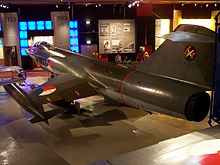
The Netherlands operated European-built F-104s with the exception of the TF-104G. These were delivered directly from Palmdale to the KLu. A total of 138 Starfighters were delivered to the Koninklijke Luchtmacht (Royal Netherlands Air Force, or KLu). [16] Many Dutch aircraft were transferred to Turkey.

Norway received 18 surplus CF-104s and four CF-104Ds from Canada in 1974, the country had initially received 19 Canadair built F-104Gs and four TF-104Gs in 1963 under the Military Assistance Program. The F-104 was phased out of Norwegian service in winter 1982.

Pakistan was the first Major non-NATO Ally to be equipped with the F-104, a total of 12 F-104A and 2 F-104B were delivered; nine F-104A (tail numbers 56-803, 56-804, 56-805, 56-807, 56-868, 56-874, 56-875, 56-877, 56-879) and two F-104B (tail numbers 57-1309, 57-1312) on 5 August 1961, [17] although some sources say the first two were landed at Sargodha Airbase (now Mushaf Airbase) by Sqn Ldr Sadruddin and Flt Lt Middlecoat in 1962. [18] One more F-104A was delivered on 8 June 1964 (tail number 56-773) and another on 1 March 1965 (tail number 56-798) as replacements for the lost starfighters in accidents. [18] Pakistani starfighters were ex-USAF Air Defence Command aircraft retro-fitted with the more powerful General Electric J-79-11A engines and, at the PAF's request, the 20 mm Vulcan gatling gun was re-installed after removal by the USAF. These F-104s had unusually high thrust to weight ratios due to the older but lighter airframe and more modern engines. [17] [18] The F-104 was in service for 12 years with 11,690 flight hours, 246 hours 45 minutes of these in the 1965 Indo-Pakistan War and 103 hours 45 minutes in the 1971 Indo-Pakistan War, after which five F-104 remained and were grounded by lack of spares due to post war U.S. sanctions. The type was phased out in late 1972. [17] [18]

The Spanish Air Force received their F-104s under the Military Assistance Program: 18 Canadair-built F-104Gs and three Lockheed-built TF-104Gs were delivered under MAP to Spain's Ejército del Aire in 1965. [19] These aircraft were transferred to Greece and Turkey when they were replaced by F-4 Phantoms in 1972. It is notable that no aircraft were lost through accidents during 17,000 hours of operational use in Spain although the aircraft was used only in its intended role of an interceptor and mainly in very good flying weather. [20]

ROC operated a total of 282 aircraft funded by the Military Assistance Program (MAP); a mixture of new-build and surplus F-104A, -B, -D, -G, -J, -DJ, RF-104G, and TF-104G were used. The Starfighter was phased out of Taiwanese service by 1997. [21]

Turkey received 48 new-build F-104Gs and six TF-104Gs from Lockheed and Canadair production, funded under the Military Assistance Program, which were delivered from 1963, and directly purchased 40 new F-104S interceptors from Fiat in 1974–75. [22] In addition, like Greece, Turkey received large numbers of surplus Starfighters from several NATO nations in the 1970s and 1980s, including 170 ex-German aircraft, 53 aircraft from the Netherlands and 52 from Canada. In total, Turkey received over 400 Starfighters from various sources, although many of these aircraft were broken up for spares without having been flown. The F-104 was finally retired from Turkish service in 1995. [23]

Eleven F-104s (different versions) were operated by NASA between 1956 and 1994. Aircraft were used in support of the X-15 and XB-70 flight testing and were also used for astronaut training during various spaceflight programs. NASA F-104 aircraft were used to gather flight research data including aircraft handling characteristics, such as roll inertia coupling, and reaction control systems as used in the NF-104A and X-15. Space Shuttle thermal protection tiles were tested in flights aboard a Starfighter on a rig which simulated flight through rain. NASA's Starfighters flew many safety chase sorties in support of advanced research aircraft over the years, including the wingless lifting body aircraft. Neil Armstrong was one notable pilot who flew a NASA F-104. [24]

The team based in Clearwater, Florida currently operate three Canadair CF-104 Starfighters, performing at air shows across the United States and Canada. Their CF-104s consist of a two-seat CF-104D Serial#:104632 (registered as N104RB), and two single-seat CF-104s Serial#s: 104850 (registered as N104RD) and 104759 (registered as N104RN). The aircraft were originally operated with the Royal Canadian Air Force and all later served with the Royal Norwegian Air Force before being imported into the U.S. in the early 1990s. [25]
Another civilian Starfighter, called the F-104RB (for Manfred von Richthofen, the "Red Baron"), was used to set the low-level speed record in October 1977 by world-famous air racer Darryl Greenamyer. Greenamyer built his F-104 over a period of 12 years from parts scrounged from various places, including a "borrowed" J79-17/1 turbojet from a McDonnell Douglas F-4 Phantom, which developed over 2,000 pounds more thrust than the standard J79-19 engine. Greenamyer attacked the record at Mud Lake, near Tonapah, Nevada, and beat the previous low-level speed record by recording a top speed of 988.26 mph (1,590.41 km/h) after five passes over the dry lake. He remained supersonic for most of the 20-minute flight, and rarely rose much higher than 100 feet above the lake bed. Several months later, while practicing for an attempt on the world absolute altitude record, he was forced to eject when his landing gear failed to extend; a belly landing in the F-104 was considered too dangerous to attempt.
| Operated | Lockheed | Canada | Germany | Netherlands | Belgium | Italy | Japan | |
|---|---|---|---|---|---|---|---|---|
| USAF | 297 | 297 | ||||||
| USAF/MAP | 250 | 110 | 140 | |||||
| Canada | 238 | 38 | 200 | |||||
| Japan | 230 | 23 | 207 | |||||
| Germany | 917 | 240 | 283 | 255 | 89 | 50 | ||
| Netherlands | 138 | 14 | 99 | 25 | ||||
| Belgium | 112 | 3 | 109 | |||||
| Italy | 354 | 12 | 342 | |||||
| subtotals | Grand: 2536 | 737 | 340 | 283 | 354 | 198 | 417 | 207 |

The Lockheed F-104 Starfighter is an American single-engine, supersonic air superiority fighter which was extensively deployed as a fighter-bomber during the Cold War. Created as a day fighter by Lockheed as one of the "Century Series" of fighter aircraft for the United States Air Force (USAF), it was developed into an all-weather multirole aircraft in the early 1960s and produced by several other nations, seeing widespread service outside the United States.

The Century Series is a popular name for a group of US fighter aircraft representing models designated between F-100 and F-106 which went into full production. They included the first successful supersonic aircraft designs in the United States Air Force's service, which remained in active service well into the 1970s and 1980s with the Air Force Reserve and Air National Guard. Three later variants, the QF-100, QF-102, and QF-106, also continued in service, primarily as aerial target drones, until the late 1990s. The F-104G stayed in service with the Italian military until 2004. The NASA airborne science program maintains a group of F-104G in airworthy condition for use as test platforms and chase aircraft.

Luke Air Force Base is a United States Air Force base in Maricopa County, Arizona, United States. It is located 7 miles west of the central business district of Glendale, and 15 miles west of Phoenix.

The Canadair CF-104 Starfighter is a modified version of the Lockheed F-104 Starfighter supersonic fighter aircraft built in Canada by Canadair under licence. It was primarily used as a ground attack aircraft, despite being designed as an interceptor. It served with the Royal Canadian Air Force (RCAF) and later the Canadian Armed Forces (CAF) until it was replaced by the McDonnell Douglas CF-18 Hornet.

The 319th Expeditionary Reconnaissance Squadron is a provisional United States Air Force unit stationed at Kanoya Air Base, Japan, operating General Atomics MQ-9 Reaper unmanned reconnaissance vehicles.

The Aeritalia F-104S Starfighter was a licensed production Italian version of the Lockheed F-104 Starfighter, which served in the Italian Air Force, and was its mainstay from the late 1960s until the beginning of the 21st century. The F-104S also served in the Turkish Air Force until the mid-1990s. The F-104S was the final development of the Starfighter line.
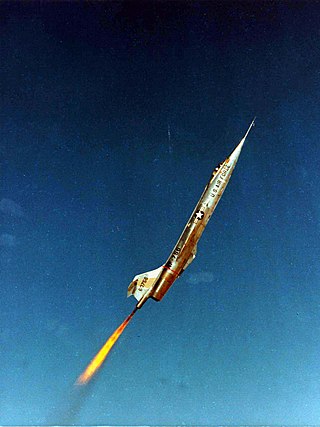
The Lockheed NF-104A was an American mixed-power, high-performance, supersonic aerospace trainer that served as a low-cost astronaut training vehicle for the North American X-15 and projected Boeing X-20 Dyna-Soar programs.
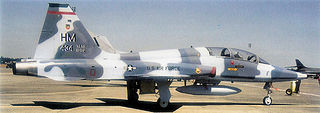
The 479th Tactical Training Wing is an inactive United States Air Force unit. Its last assignment was with Tactical Training, Holloman, stationed at Holloman Air Force Base, New Mexico. It was inactivated on 26 July 1991.

The 69th Fighter Squadron is a United States Air Force Reserve fighter squadron. It is assigned to the 944th Operations Group, stationed at Luke Air Force Base, Arizona.

The 418th Test and Evaluation Squadron is an active United States Air Force unit assigned to the 53rd Test and Evaluation Group, and stationed at Davis-Monthan Air Force Base, Arizona, where it was activated on 1 October 2021.

The 331st Fighter-Interceptor Squadron is an inactive United States Air Force unit. Its last assignment was with Air Defense Command at Webb Air Force Base, Texas, where it was inactivated on 1 March 1967.

The 337th Flight Test Squadron was most recently part of the 46th Test Wing and based at McClellan Air Force Base, California. It performed depot acceptance testing until being inactivated with the closure of McClellan on 13 July 2001.
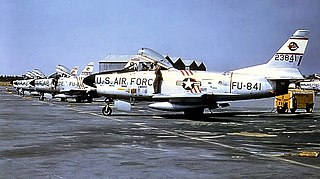
The 4729th Air Defense Group is a discontinued United States Air Force organization. Its last assignment was with the Boston Air Defense Sector at Westover Air Force Base, Massachusetts, where it was discontinued in 1958.

The 538th Fighter-Interceptor Squadron is a discontinued unit of the United States Air Force. It was last assigned to the Spokane Air Defense Sector at Larson Air Force Base, Washington, in mid-1960.

Starfighters Inc is a civilian organization that uses F-104 Starfighters for contract testing and flight simulations.

The 476th Tactical Fighter Squadron is an inactive United States Air Force unit. It flew North American F-100 Super Sabre and Lockheed F-104 Starfighter fighters at George Air Force Base, California from October 1957 until 1968, when moved to Seymour Johnson Air Force Base, where was to fly McDonnell F-4 Phantom IIs, but did not become operational before inactivating in March 1969.

Taoyuan Air Base was a Republic of China Air Force base located in Taoyuan, Taiwan, southeast of Taipei's civilian Taoyuan International Airport. In 2007, the site was turned over to the Republic of China Navy and was renamed to Taoyuan Naval Base.

The 12th Tactical Reconnaissance Squadron is an active unit of the Republic of China Air Force. It is part of the 401st Tactical Composite Wing and operates the General Dynamics F-16A/B Fighting Falcon, Northrop RF-5E Tigergazer and Northrop F-5F Tiger II from Hualien Air Force Base, Hualien County.